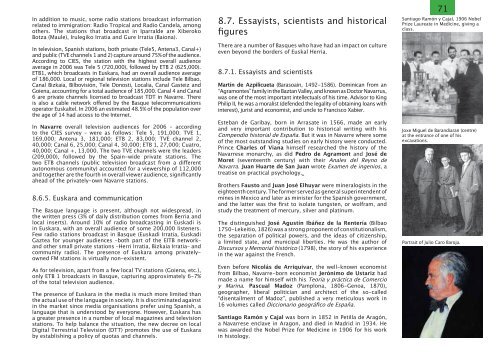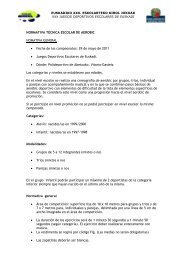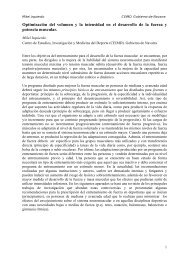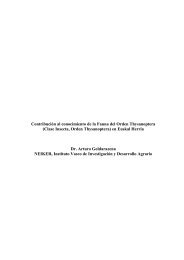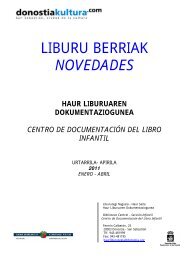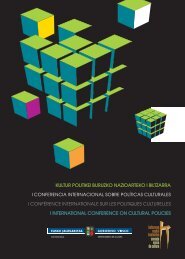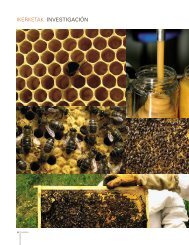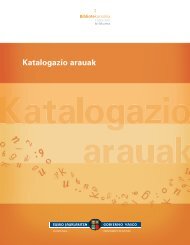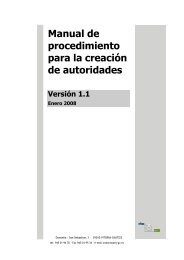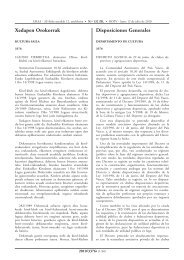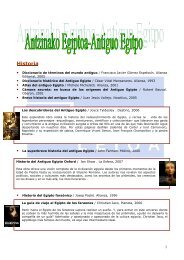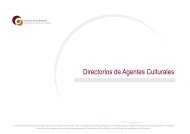The Basque Country (pdf, 4,3Mb) - Kultura Saila - Euskadi.net
The Basque Country (pdf, 4,3Mb) - Kultura Saila - Euskadi.net
The Basque Country (pdf, 4,3Mb) - Kultura Saila - Euskadi.net
You also want an ePaper? Increase the reach of your titles
YUMPU automatically turns print PDFs into web optimized ePapers that Google loves.
In addition to music, some radio stations broadcast information<br />
related to immigration: Radio Tropical and Radio Candela, among<br />
others. <strong>The</strong> stations that broadcast in Iparralde are Xiberoko<br />
Botza (Maule), Irulegiko Irratia and Gure Irratia (Baiona).<br />
In television, Spanish stations, both private (Tele5, Antena3, Canal+)<br />
and public (TVE channels 1 and 2) capture around 75% of the audience.<br />
According to CIES, the station with the highest overall audience<br />
average in 2006 was Tele 5 (720,000), followed by ETB 2 (625,000).<br />
ETB1, which broadcasts in Euskara, had an overall audience average<br />
of 186,000. Local or regional television stations include Tele Bilbao,<br />
Canal Bizkaia, Bilbovisión, Tele Donosti, Localia, Canal Gasteiz and<br />
Goiena, accounting for a total audience of 185,000. Canal 4 and Canal<br />
6 are private channels licensed to broadcast TDT in Navarre. <strong>The</strong>re<br />
is also a cable <strong>net</strong>work offered by the <strong>Basque</strong> telecommunications<br />
operator Euskaltel. In 2006 an estimated 48.5% of the population over<br />
the age of 14 had access to the Inter<strong>net</strong>.<br />
In Navarre overall television audiences for 2006 – according<br />
to the CIES survey – were as follows: Tele 5, 191,000; TVE 1,<br />
169,000; Antena 3, 181,000; ETB 2, 83,000; TVE channel 2,<br />
40,000; Canal 6, 25,000; Canal 4, 30,000; ETB 1, 27,000; Cuatro,<br />
40,000; Canal +, 13,000. <strong>The</strong> two TVE channels were the leaders<br />
(209,000), followed by the Spain-wide private stations. <strong>The</strong><br />
two ETB channels (public television broadcast from a different<br />
autonomous community) accounted for a viewership of 112,000<br />
and together are the fourth in overall viewer audience, significantly<br />
ahead of the privately-own Navarre stations.<br />
8.6.5. Euskara and communication<br />
<strong>The</strong> <strong>Basque</strong> language is present, although not widespread, in<br />
the written press (3% of daily distribution comes from Berria and<br />
local inserts). Around 10% of radio broadcasting in <strong>Euskadi</strong> is<br />
in Euskara, with an overall audience of some 200,000 listeners.<br />
Few radio stations broadcast in <strong>Basque</strong> (<strong>Euskadi</strong> Irratia, <strong>Euskadi</strong><br />
Gaztea for younger audiences –both part of the EITB <strong>net</strong>work–<br />
and other small private stations –Herri Irratia, Bizkaia Irratia– and<br />
community radio). <strong>The</strong> presence of Euskara among privatelyowned<br />
FM stations is virtually non-existent.<br />
As for television, apart from a few local TV stations (Goiena, etc.),<br />
only ETB 1 broadcasts in <strong>Basque</strong>, capturing approximately 6-7%<br />
of the total television audience.<br />
<strong>The</strong> presence of Euskara in the media is much more limited than<br />
the actual use of the language in society. It is discriminated against<br />
in the market since media organisations prefer using Spanish, a<br />
language that is understood by everyone. However, Euskara has<br />
a greater presence in a number of local magazines and television<br />
stations. To help balance the situation, the new decree on local<br />
Digital Terrestrial Television (DTT) promotes the use of Euskara<br />
by establishing a policy of quotas and channels.<br />
8.7. Essayists, scientists and historical<br />
figures<br />
<strong>The</strong>re are a number of <strong>Basque</strong>s who have had an impact on culture<br />
even beyond the borders of Euskal Herria.<br />
8.7.1. Essayists and scientists<br />
Martín de Azpilicueta (Barasoain, 1492-1586). Dominican from an<br />
“Agramontes” family in the Baztan Valley, and known as Doctor Navarrus,<br />
was one of the most important intellectuals of his time. Advisor to King<br />
Philip II, he was a moralist (defended the legality of obtaining loans with<br />
interest), jurist and economist, and uncle to Francisco Xabier.<br />
Esteban de Garibay, born in Arrasate in 1566, made an early<br />
and very important contribution to historical writing with his<br />
Compendio historial de España. But it was in Navarre where some<br />
of the most outstanding studies on early history were conducted.<br />
Prince Charles of Viana himself researched the history of the<br />
Navarrese monarchy, as did Pedro de Agramont and José de<br />
Moret (seventeenth century) with their Anales del Reyno de<br />
Navarra. Juan Huarte de San Juan wrote Examen de ingenios, a<br />
treatise on practical psychology.<br />
Brothers Fausto and Juan José Elhuyar were mineralogists in the<br />
eighteenth century. <strong>The</strong> former served as general superintendent of<br />
mines in Mexico and later as minister for the Spanish government,<br />
and the latter was the first to isolate tungsten, or wolfram, and<br />
study the treatment of mercury, silver and platinum.<br />
<strong>The</strong> distinguished José Agustín Ibáñez de la Rentería (Bilbao<br />
1750-Lekeitio, 1826) was a strong proponent of constitutionalism,<br />
the separation of political powers, and the ideas of citizenship,<br />
a limited state, and municipal liberties. He was the author of<br />
Discursos y Memorial histórico (1798), the story of his experience<br />
in the war against the French.<br />
Even before Nicolás de Arriquivar, the well-known economist<br />
from Bilbao, Navarre-born economist Jerónimo de Ustariz had<br />
made a name for himself with his Teoría y práctica de Comercio<br />
y Marina. Pascual Madoz (Pamplona, 1806-Genoa, 1870),<br />
geographer, liberal politician and architect of the so-called<br />
“disentailment of Madoz”, published a very meticulous work in<br />
16 volumes called Diccionario geográfico de España.<br />
Santiago Ramón y Cajal was born in 1852 in Petilla de Aragón,<br />
a Navarrese enclave in Aragon, and died in Madrid in 1934. He<br />
was awarded the Nobel Prize for Medicine in 1906 for his work<br />
in histology.<br />
71<br />
Santiago Ramón y Cajal, 1906 Nobel<br />
Prize Laureate in Medicine, giving a<br />
class.<br />
Joxe Miguel de Barandiaran (centre)<br />
at the entrance of one of his<br />
excavations.<br />
Portrait of Julio Caro Baroja.


